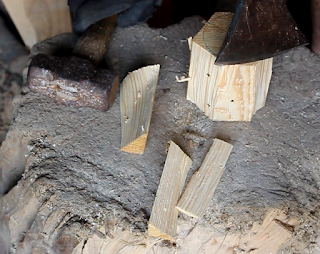 |
| Completed Studio Light |

Although we have been to work around this problem by photographing in daylight, that is not always possible. For example, it precludes us working at night and causes problems on dull Winter days! We have recently taken on two projects which require us to photograph outside daylight hours. Furthermore, these projects one involving food photography and the other animation will require a professional lighting approach. In particular the animation will need precise, consistent and controllable illumination of the subjects and set.
(Photo below of set taken with our tablet).
PHASE ONE - PROTOTYPE SINGLE FIXED ARM
MATERIALS
These were simply recuperated light fittings, a couple of 6500K 11W 230V daylight bulbs and pallet wood.
STEP ONE - THE STAND
Some years ago I made a wooden base for a large garden umbrella/sunshade.
The tube of the umbrella fits into the square support hole of the base and the stand for the lights should likewise fit this aperture.
We have been using this stand on our old light, (see left) and it has worked well and given us a solid support.
The slot was cut was made using the circular saw, the guide of which was set so the cut was made 5mm (3/16”) from the centre line. After the first cut for the slot was completed, I turned the plank over and made the second cut thus avoiding the need to alter the guide on the saw – the symmetry of the cuts being around the central axis of the plank. The second plank was cut the same way. I drilled a 10mm diameter hole at the ends of the saw cuts thus allowing the central portion to be removed.
The planks were placed on top of each other to check that the two slots aligned when the outer edges were aligned. The planks were then joined together using PVA wood adhesive and nails.
STEP TWO - LIGHT SUPPORT ARM
Initially I decided to mount both fittings at the ends of a common horizontal arm 100cm (39”) long once again a pallet plank. A 10mm threaded bar at the midpoint of the plank attached it to the stand through the slot. I made a large knob with a 10mm nut fitted into it.
The knob was large enough to ensure sufficient tightening force could be applied to secure the arm in position without recourse to a spanner.
The knob was turned from a nail-free pallet block.
I turned the block to 60mm (2”) diameter which I felt was a comfortable fit for my hand. A counterbored hole was made in the centre of one face of the knob, slightly smaller than a 10mm nut and deeep enough for the nut to be flush with the face. A clearance hole for the 10mm bar was drilled through the central long axis of the knob.
I turned the block to 60mm (2”) diameter which I felt was a comfortable fit for my hand. A counterbored hole was made in the centre of one face of the knob, slightly smaller than a 10mm nut and deeep enough for the nut to be flush with the face. A clearance hole for the 10mm bar was drilled through the central long axis of the knob.
The knob was placed between the jaws of a bench vice and the nut was placed over the recessed hole. The vice was then closed on the knob forcing the nut into the undersized hole until it was flush with the knob face.
The light fittings were attached at the extreme ends of the arm and this was then attached to the stand.
Now if you'd like, sit back and watch the film, where you will also see the results of the lighting tests and comparison between our old and new lights.
Part Two will be coming shortly.
Please feel free to share this article, comment and/or ask for further information.
Until next time!
Cheers, Andy
© Andy Colley 2017








